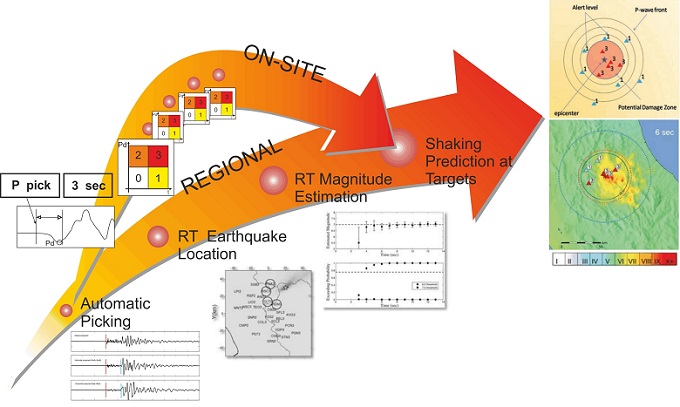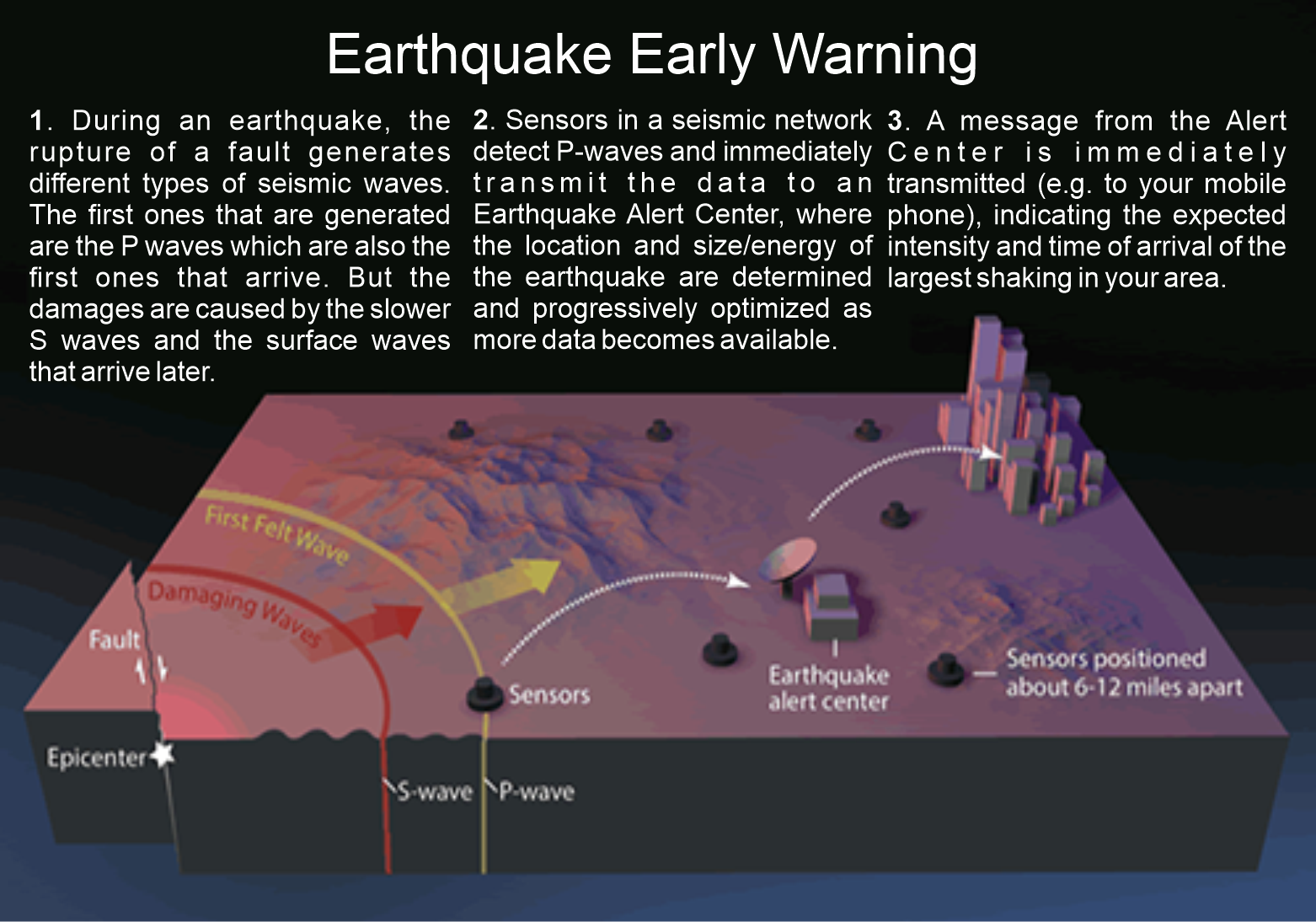The Early Warning is the alert issued immediately after detecting a potentially dangerous event (e.g. earthquake) and before it reaches a specific site of interest.
The Earthquake Early Warning (EEW) is therefore not a prediction of the occurrence of an earthquake, since the event has already occurred, but of the intensity with which the seismic event will reach a particular site.
A seismic-accelerometer network has the ability, through an Earthquake Early Warning (EEW) or Seismic Early Warning system (e.g. Zollo et al., 2010), to issue a warning before the arrival of the strong ground motion associated with the earthquake.
Assuming a dense network of stations, like the one currently throughout the Italian territory, theoretical lead-time calculations indicate that for events of M 6 and M 7, the alert of an on-site/regional EEW system would reach the inhabitants of the areas most exposed to earthquake damage in about 5-6 seconds after the time of origin of the event, including the delay required by the automatic processing and analysis of seismic signals in real-time, with a blind zone radius of 10-20 km around the epicentre.
Considering for example the area of damage observed after the L'Aquila earthquake, the theoretical lead-time would have been between about 3 and 8 seconds in a large area within the zone where the greatest damage was observed.
For the Irpinia earthquake of 1980, the area of damage was larger (about 100 km away from the epicenter) and consequently the region that could have benefited from a positive lead-time would have been greater, with lead-times available for safety measures of between 3 and 20 seconds.
However, the lead time for precautionary measures is likely to be longer than that indicated by the theoretical calculations, since the maximum acceleration/velocity levels of ground motion, potentially generating damages, are rarely associated with the first arrivals of S-waves. Moreover, the failure of non-structural elements or partial/total collapses of buildings are not instantaneous and simultaneous with the first arrival of S-waves and also in this case the lead time could be longer than that estimated theoretically.
EEW systems can be useful to mitigate the impact of medium and large earthquakes. The ability of such systems to provide the location and magnitude of the earthquake in "real time" can be used to activate countermeasures prior to the arrival of the strongest waves at the site of interest. Even when the distances from the source of the earthquake and consequently the warning times do not allow evacuating structures and infrastructures at risk, the information provided by an EEW system can be used to automatically activate measures (e.g. shutting off gas supply, disconnecting electricity) that significantly reduce almost instantaneously the vulnerability and/or exposure of structures of interest and therefore the expected loss. They can also be useful for activating slowdown/stop mechanisms of transport systems, production in industrial areas, etc.
EEW has been experimented for at least two decades in various parts of the world and also in Irpinia in Italy. In 2008, Japan launched the Early Warning Broadcast, i.e. the capillary diffusion through mass media of the instant warning message as well as promoting education and information campaigns for the population. In the United States, EEW has been tested in California for several years through the CISN integrated seismic network. The USGS, the U.S. Geological Survey, responsible for seismic monitoring on a national scale, has launched the 'Shake Alert' project. Working with a consortium of university partners, the project aims to test Early Warning in states along the West Coast that are threatened by earthquakes along the infamous San Andreas Fault or further north in the Cascadia subduction zone. The European community has funded in the last decade two projects in succession, SAFER and REAKT, with the aim of developing and testing Early Warning in the main seismic zones of the Euro-Mediterranean area. Within these projects, a prototype of a Regional Early Warning System (PRESTo) developed at the Physics Department of the University of Naples Federico II has been implemented in Southern Italy and is in operation for research purposes.

PRESToPlus flowchart (from Zollo et al., 2010)
The onsite EEW (e.g. Caruso et al. 2017; Zollo et al., 2014), does not include very robust algorithms for the detection of real-time events and can typically lead to incorrect recognition of P- and S-wave arrivals, causing a high number of false alarms. Moreover, in the case of civil infrastructures with numerous users such as schools (Picozzi et al., 2015), where an on-site EEW is more useful, the number of false detections due to anthropogenic noise is likely to become huge. However, solutions to this problem have been carefully analyzed and it is possible to filter high-frequency signals and choose highly selective threshold parameters, leading to on-site EEW being effective only for high-magnitude events. It should be noted that the use of accelerometers normally results in a reduced number of false picks as the anthropogenic signals are masked by the high frequency instrumental noise of these sensors. These results suggest that a single-station EEW approach can be highly problematic to implement, as it would require a specific and very complex tuning of the picking parameters to avoid the identification of false events. However, when the announcement of events is required at least at three stations and within a small-time window, e.g. 0.5 s, the detection of false events decreases significantly over the day, to 1 or 2 events per day on average. In addition, the occurrence of false events can be entirely avoided when picking coincidence within 0.5 s is required at four or five stations.
In countries like Italy, where the distance between seismic sources and target sites (to be protected) is, in most cases, only a few tens of kilometres, on-site EEWS such as the one to be installed in the historical centre of Catania could represent a valid strategy to integrate a regional EEW network.
Bibliographic References
Caruso A., Colombelli S., Elia L., Picozzi M. and Zollo A., An on-site alert level early warning system for Italy, Journal of Geophysical Research: Solid Earth, 10.1002/2016JB013403, 2017
Colombelli S., Caruso A., Zollo A., Festa G., and Kanamori H, A P wave-based, on-site method for earthquake early warning, Geophysical Research Letters, 10.1002/2014GL063002, 2014
Picozzi M., Martino C., Emolo A. and Zollo A., Earthquake Early Warning System for Schools: A Feasibility Study in Southern Italy, Seismological Research Letters Volume 86, Number 2A, 10.1785/0220140194, 2015
Tusa G., Musumeci, C., Patane, D., Estimation of Earthquake Early Warning Parameters for Eastern Sicily, Bulletin of the Seismological Society of America, 10.1785/0120160247, 2017
Zollo A., Amoroso O., Lancieri M., Wu Y.M., and Kanamori H., A threshold-based earthquake early warning using dense accelerometer networks, Geophys. J. Int. 183, 963–974, 2010
Zollo A., Colombelli S., Elia L., Emolo A., Festa G., Iannaccone G., Martino C. and Gasparini P., An integrated regional and on-site earthquake early warning system for southern Italy: Concepts, methodologies and performances, in Early Warning for Geological DisastersScientific Methods and Current Practices, edited by F. Wenzel and J. Zschau, pp. 117–137, Springer, Berlin, 2014.



